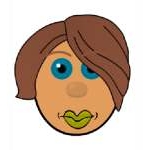
 |
Design A Face |
Who likes to make a face? In this activity, children will have lots of fun experimenting with the many design tools to make wonderful faces. They will also extend their knowledge of words for different facial features and descriptive words.
Part of the screen is filled with two columns of boxes. These contain a number of sliders for particular facial features and accessories, and are described below.
The sliders can be moved left or right by clicking on the line or using click and drag mouse control. As they are moved, features on the face to the right of the sliders will change.
Face - return to the face design page when on the body page
Stick figure - when a face design is finished, click on this button to see it used for a complete body. Use the slider on the left side of the screen to view different body choices.
| Turn the music and sounds on and off | |
| Return to the original face design | |
| Random face picker | |
| Exit |
Outcome 1: Children have a strong sense of identity
Outcome 4: Children are involved and confident learners
Outcome 5: Children are effective communicators
Creativity
Experimentation
Decision-making
Colours
Size
Emotions
Facial features
Part/whole concepts
Extending and reinforcing vocabulary
Mouse controls - single click and click and drag
Use sliders to view options
This is a great activity that can be played alone or with a friend. Encourage children to try all the different sliders and use their wonderful imagination to make lots of designs. Click on the random button to get new ideas for designs or new faces to manipulate. There is no right or wrong result, so this method of open-ended learning is great for building self-confidence and promoting independent decision-making.
If playing with a friend, players can challenge each other by describing a desired look and asking their partner to match it. This requires the use of effective verbal communication, listening skills and comprehension.
Children's vocabulary will be extended and reinforced as they talk about different facial features, expressions and looks. Descriptive words that involve size, shape, colour and emotions will be used.
Emotions will be explored. You can ask children to make a happy or sad face. What facial features are they using? What features do they need to change to make a puzzled face? Can they make that face on the computer?
Challenge children to make their own face�. as close as possible. Place a small mirror close by so that they can observe their facial features and try to recreate them. Try to match eye colour, hair length, face shape.
Have fun using the accessories and trying out different bodies.
A double-click is the act of pressing your mouse button quickly two times without moving the mouse. This skill is used to perform a number of actions, such as opening a program or folder, or selecting a word of text.
Double clicking involves clicking your mouse button quickly two times. To perform a double click, and not just two clicks, the mouse button must be pressed twice within a very short time, typically about half a second. Most operating systems will allow you to lengthen or shorten the maximum time allowed for a double click, using the Mouse Control Panel or System Preference.
New mouse users often have difficulty with double-clicking. Clicking fast enough or keeping the mouse still while double-clicking are the main points of difficulty. To help children with this skill, initially hold the top of the mouse near the cord to keep it still and ask them to say "click, click" as they double click. Ask them to click a little faster, if needed. Practice by moving their index finger in the clicking motion away from the mouse. E.g. On the table.
As children become more familiar with this skill they will attempt it by themselves. Praise them when they attempt this new skill, encouraging them to keep trying when they don't succeed. Allow them to have a go a few times before stepping in to help.
Remember that this is a difficult skill to master not only for children, but for adults too.